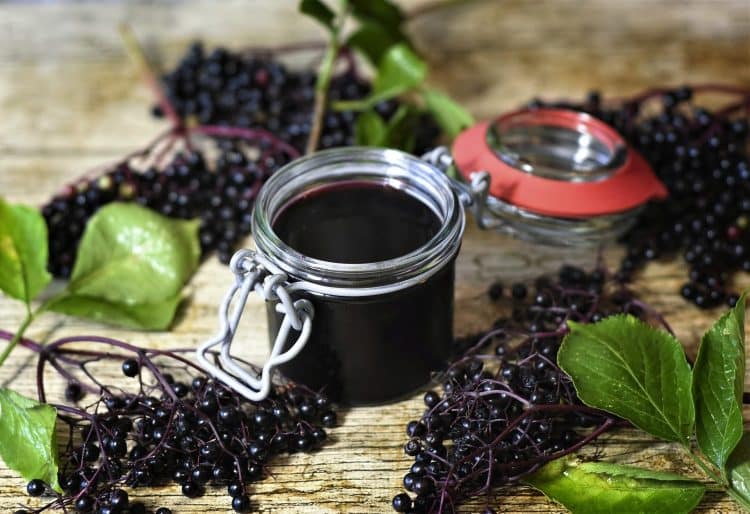Elderberries are a rich source of antioxidants, particularly anthocyanins, which are flavonoid pigments that produce the color in grapes, eggplants and even purple cannabis flowers. Because of their health benefits, which include protection from certain cancers and cardiovascular diseases, anthocyanins are highly sought after in the health and wellness industry. [1]
After the juice of elderberries has been extracted from the fruit, a pomace remains that is rich in anthocyanins. Using an optimal extraction method, this “pulp,” which is often discarded or used for fertilizer or animal feed, can yield significant quantities of anthocyanins that can be used in both the food and pharmaceutical industries. [2]
In natura pomace and dried pomace from elderberries grown in Portugal were used in a series of anthocyanin extraction experiments that produced promising results. [2,3] The mechanically-pressed pomace was dehydrated without light at 308 K over a 12-hour period and then milled in a grinder. [2,3]
The researchers used fractionated high-pressure extraction by performing supercritical CO2 extraction followed by “enhanced solvent extraction (ESE)” with different combinations of CO2, ethanol (EtOH), and water (H2O). Anthocyanin-rich extractions were the target of the second step, which employed a temperature of 313 K and pressure of ~20-21 MPa. The yields of these extracts differed depending on co-solvent composition.
The first step of the extraction process (CO2 supercritical fluid extraction) removed less polar, lipophilic compounds and produced a yield of roughly 17% w/w from the dried pomace. [2,3] In natura pomace produced much lower yield on the first step (~3%) possibly due to the presence of seeds and polar H2O. [3]
The highest yield from ESE (24.2%) occurred when no CO2 was used in the solvent mixture (20% EtOH and 80% H2O by volume). That said, high ESE yields were still obtained with EtOH/H2O mixtures containing high amounts of CO2, which is beneficial given the potential of recycling CO2. For example, total yield of 20.4% (all anthocyanin-rich) was obtained with 80% CO2, 1% EtOH, and 19% H2O. [2]
When high amounts of CO2 were used with low-to-no H2O, anthocyanin-rich extractions could not be obtained in the 45-minute time frame used for ESE. Additionally, the use of pure EtOH and near-pure H2O for ESE produced lower yields than the CO2/EtOH/H2O mixtures at 13.9% and 15.2%, respectively. [2]
In essence, the presence of H2O and EtOH were proven to be beneficial for the extraction of anthocyanins from elderberry pomace as opposed to using CO2 alone for SFE. Additionally, using EtOH and H2O alone during ESE was also demonstrated to be less effective in abstracting anthocyanins than when used together in a solvent mixture. [2,3]
The results are encouraging because they demonstrate that a more complete usage of the elderberry (and other fruits and plants containing anthocyanins) is possible beyond the production of juice; the post-juicing pomace can be an economically viable product destined for pharmaceutical and food destinations and not just for livestock and fertilizer.
Image Source: RitaE from Pixabay
References:
- He J, Giusti MM. Anthocyanins: Natural colorants with health-promoting properties. Annu Rev Food Sci Technol. 2010;1(1):163-187. doi:10.1146/annurev.food.080708.100754. [Impact factor: 8.960; Times cited: 746]
- Seabra IJ, et al. Effect of solvent (CO2/ethanol/H2O) on the fractionated enhanced solvent extraction of anthocyanins from elderberry pomace. The Journal of Supercritical Fluids. 2010; 54:145-152. [Impact factor: 3.744; Times cited: 83]
- Seabra IJ, et al. Fractioned high pressure extraction of anthocyanins from elderberry (Sambucus nigra L.) pomace. Food and Bioprocesses Technology. 2008;3:674-683. [Impact factor: 3.356; Times cited: 52











